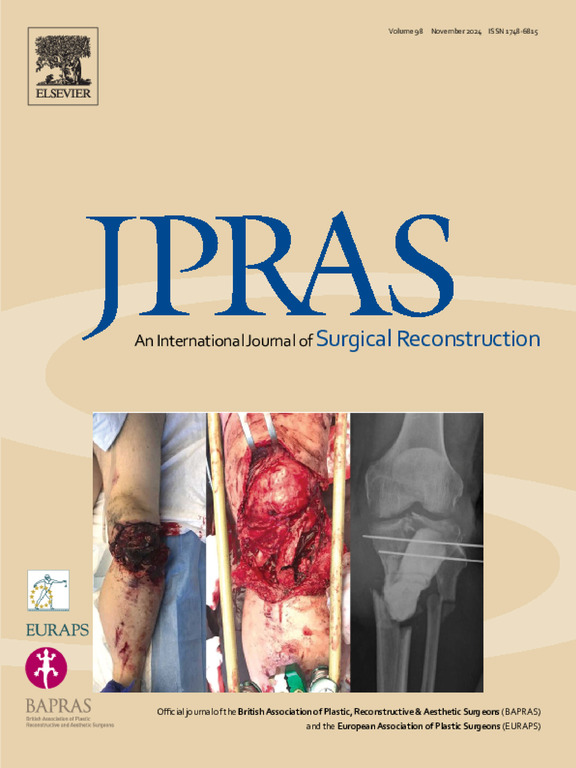整形手术质量提高术后恢复(ERAS)研究:系统综述。
IF 2
3区 医学
Q2 SURGERY
Journal of Plastic Reconstructive and Aesthetic Surgery
Pub Date : 2025-02-01
DOI:10.1016/j.bjps.2024.11.063
引用次数: 0
摘要
背景:为了改善术后预后,手术后增强恢复(ERAS)方案越来越受欢迎。本系统综述的目的是评估整形外科ERAS研究的报告和方法学质量。方法:纳入2020年1月1日至2023年11月20日期间发表的所有整形外科ERAS实施研究。主要结果是基于“ERAS依从性报告、结果和要素研究(恢复)清单”的报告质量(40分)。次要结局包括ERAS®协会认可指南的方法学质量(Breast 18分;头颈部(H&N) 24分。结果:纳入50例ERAS研究(乳房重建:29.58%;头颈部:7.14%;颅面:6.12%;美学:5.10%;其他:3.6%)。平均报告质量为22.6/40(56.7%)。ERAS方案中最少遵守的要素包括:患者升温策略(8/50,16%)、术后液体管理(14/50,28%)和出院后结果跟踪(14/50,28%)。乳房方法学质量评估显示,平均依从性为9.2/18(51.3%)。术前计算机断层血管造影(4/23,17.4%)、术中温暖(6/23,26.1%)和术后伤口处理(2/23,8.7%)符合程度最低。头颈部研究的平均依从性为9.1/23(39.6%)。遵守程度最低的因素包括麻醉前止痛药(1/7,14.3%)、术后伤口护理(0/7,0%)和拔除导尿(1/7,14.3%)。结论:整形外科ERAS实施的研究变化很大,总体上报告质量和方法质量都很低。整形外科医生在采用出版的ERAS协议时应该谨慎,因为这些协议不符合推荐的和官方的ERAS®协会指南。本文章由计算机程序翻译,如有差异,请以英文原文为准。
Quality of plastic surgery Enhanced Recovery After Surgery (ERAS) studies: A systematic review
Background
In effort to improve post-operative outcomes, enhanced recovery after surgery (ERAS) protocols have gained popularity. The objective of this systematic review was to assess the reporting and methodological quality of plastic surgery ERAS studies.
Methods
All plastic surgery ERAS implementation studies, published between January 1, 2020, to November 20, 2023, were included. The primary outcome was reporting quality based on “The Reporting on ERAS Compliance, Outcomes, and Elements Research (RECOvER) checklist” (40 points). Secondary outcomes included methodology quality as per ERAS® Society endorsed guidelines (Breast 18 points; Head and Neck (H&N) 24 points).
Results
Fifty ERAS studies were included (breast reconstruction: 29, 58%; head and neck: 7, 14%; craniofacial: 6, 12%; aesthetic: 5, 10%; other: 3, 6%). Average reporting quality was 22.6/40 (56.7%). ERAS protocol elements least adhered to included: patient warming strategy (8/50, 16%), management of post-operative fluids (14/50, 28%), and post-discharge outcome tracking (14/50, 28%). Evaluation of breast methodological quality revealed average compliance of 9.2/18 (51.3%). The least complied with elements included preoperative computed tomography angiography (4/23, 17.4%), intraoperative warming (6/23, 26.1%), and post-operative wound management (2/23, 8.7%). For head and neck studies, average compliance was 9.1/23 (39.6%). The least complied with elements included pre-anesthesia pain medications (1/7, 14.3%), post-operative wound care (0/7, 0%), and urinary catheterization removal (1/7, 14.3%).
Conclusions
ERAS implementation studies in plastic surgery are highly variable, with overall low reporting and methodology quality. Plastic surgeons should be cautious when adopting published ERAS protocols that do not adhere to the recommended and official ERAS® Society guidelines.
求助全文
通过发布文献求助,成功后即可免费获取论文全文。
去求助
来源期刊
CiteScore
3.10
自引率
11.10%
发文量
578
审稿时长
3.5 months
期刊介绍:
JPRAS An International Journal of Surgical Reconstruction is one of the world''s leading international journals, covering all the reconstructive and aesthetic aspects of plastic surgery.
The journal presents the latest surgical procedures with audit and outcome studies of new and established techniques in plastic surgery including: cleft lip and palate and other heads and neck surgery, hand surgery, lower limb trauma, burns, skin cancer, breast surgery and aesthetic surgery.

 求助内容:
求助内容: 应助结果提醒方式:
应助结果提醒方式:


